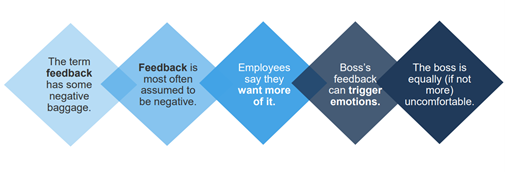ATD Blog
Honey or Hammer: What Feedback Style Are Your Leaders Using?
Mon Feb 07 2022

When I first began my career, feedback practices were unidirectional. Performance goals were typically established by managers and communicated down to staff. Likewise, performance feedback was pushed down by managers to individual contributors. Employee suggestion boxes provided one of the only means for employees to speak up, give feedback to managers, and be heard in their organizations.
Since then, organizations have experienced many changes. Organizational structures have become flatter and more matrixed, and multiple, multidirectional communication strategies and methods co-exist. Bottom line: Companies have been striving to reinvent the performance review, instill feedback-rich cultures that are characterized by more of a bidirectional flow of feedback between managers and line staff, and link feedback to development and coaching.
Enter Jack Zenger and Joe Folkman.
Zenger and Folkman are leaders in the field of organizational leadership, performance, effectiveness, and development. They shared some of their latest research and expertise about feedback practices during a recent ATD Forum ConnectSpark.
To set the context, Jack Zenger shared a personal story. He told us that after attending an event led by a chief learning officer, the CLO approached him. He told Zenger that he was giving the same talk to another audience and asked if there was one thing he could do to improve his presentation. The point of the story was that upon reflection, this one, simple request for feedback left Zenger curious about the power of a single person asking another for feedback. He’s been studying the topic ever since.
What We Already Know About Feedback
Zenger and Folkman began the meeting by describing five common characteristics of feedback (see Figure 1). In the organizational settings I’ve worked in, I’ve seen evidence of all these characteristics. Let’s take a closer look at each one.
1. Feedback has some negative baggage. Once you’ve heard it, it’s hard not to carry some feedback around with us. As the years go by, the extra weight of feedback that we didn’t necessarily understand, agree with, or were unsure what to do with can weigh down our performance on the job.
2. Feedback is most often presumed to be negative. Why do we tend to dread feedback? Could it be because sometimes feedback feels like a crushing blow? If you’ve ever felt like feedback was a hammer pounding away at you, then it’s not hard to understand why feedback is often perceived as negative and corrective.
3. Employees want more feedback. One constant that exists in organizational settings is that most employees desire feedback. They want it, they seek it out in a variety of ways, and they can thrive from it when it is offered to them in a plentiful and helpful way.
4. Boss’s feedback can trigger emotions. Whenever a person of power is delivering feedback, the message triggers emotions. Something about the inherent imbalance of power can activate defense and self-protecting mechanisms—even in the most humble and genuine learners and feedback seekers.
5. The boss is equally (if not more) uncomfortable. Zenger and Folkman’s research reveals that managers have as hard of a time delivering feedback to their employees as their employees have hearing it. That finding alone could explain why feedback-rich cultures can be so hard to cultivate and sustain.
Figure 1: What We Know About Feedback

Assumptions and Characteristics of Feedback-Rich Cultures
Using their research findings as a base, Zenger and Folkman challenge some of our traditional notions about feedback. For example, there’s a prevailing assumption that feedback needs to flow downward in an organization. But what if we challenge that assumption and establish feedback as a bidirectional or even multidirectional process? What if leaders and managers set a new example by asking for feedback—routinely, effectively, predictably—about their own performance?
What if managers and employees would both act as providers and recipients of feedback, equally engaging in feedback exchanges with one another throughout the performance period? According to Zenger and Folkman, when this is the approach to feedback, the organization will see:
An inherently higher volume of overall feedback present due to the bidirectional “pull” and “ask” that is at work in the organizational setting
Higher levels of receptivity to and implementation of the feedback being exchanged
Recognition of the leaders as the models of this practice because they are asking and responding to feedback frequently, routinely, and responsively (“leaders as teachers” concept)
Feedback more focused on helping everyone develop their strengths (less corrective, more growth-oriented)
Employees feeling more empowered by feedback with a greater sense of personal control over their performance contributions, improvement efforts, and outcomes
Behavior that looks more like “adults treating adults like adults” than “adults treating adults like children”
Why Strive for a Feedback-Rich Culture?
Why should we care about changing organizational feedback practices? Zenger and Folkman’s research looked at 360 survey feedback data for more than 100,000 leaders spanning multiple industries across the globe. They found a couple of strong correlations:
When a leader was rated as being “highly effective at asking for feedback,” they were also considered to be effective at “giving honest feedback in a helpful way.”
When a leader was rated as being “highly effective at asking for feedback,” their overall effectiveness was also rated high.
Clearly, leaders who ask for and provide honest, effective feedback in a helpful way not only impact the performance of others, they also impact overall organization performance outcomes and are viewed as some of most effective leaders inside their companies.
Zenger and Folkman’s research also explores feedback style differences. They examine the extent to which managers prefer or avoid giving positive and negative feedback and the impact those preferences have on the feedback’s recipients.
Consider this question: Why would well-meaning, high-performing managers in any company avoid giving positive feedback or prefer to give negative feedback? Zenger and Folkman explained that some managers simply think part of their job is to critique. Others confuse constructive with critical; they believe that the main way to help people improve performance is by delivering critical (think: negative) feedback. Unfortunately, that approach doesn’t always win. As Abraham Maslow pointed out: When all you have is a hammer, everything looks like a nail.
But there are inherent dangers in giving predominantly negative feedback. It can damage relationships; lower morale, which in turn reduces effort on the job; and trigger threat/danger responses.
Data from Zenger and Folkman further reveals:
Giving no feedback at all is viewed as more effective than giving mostly negative feedback.
Giving a balance of feedback is important.
Leaders who err on the side of delivering more positive than negative feedback produce greater positive impact in their organizations.
Now, consider the adage, “You can catch more flies with honey than with vinegar.” To achieve higher levels of talent effectiveness and strong performance results, perhaps we need more honey than hammers to fuel effective feedback practices.
Steps to Cultivating a Feedback-Rich Culture
Zenger and Folkman concluded our session by issuing a few challenges to everyone who works in talent development:
Get familiar with Zenger and Folkman’s Feedback Styles survey. It’s a short, 11-question survey that assesses feedback providers’ preferences for delivering positive and negative feedback.
Develop leaders who ask for feedback. One of the most impactful things TD professionals can do is develop leaders and managers to model the practice of asking for feedback—from their superiors, from their peer leaders, and from their own staff. Teach them to not only give but ask for feedback frequently, and help them develop the skills of listening, hearing, being receptive, and responding accordingly.
Teach your frontline workers to ask. Frontline workers typically represent the largest body of employees in your company setting. If you teach them to request feedback—to solicit it by asking for it from their superiors and their peers—then you are creating a groundswell of feedback-rich activity that can change your way of working at scale. Consider it a “pull-pull” challenge. If you are aiming to foster a feedback-rich environment, then you need everyone pulling for it from every organizational level, all the time.
Start promoting feedback skills that are fueled more by honey than hammers. Not only will employees thank you for the more frequent, helpful, and growth-oriented feedback, your organization’s bottom-line performance will benefit, too. Finally, take a cue from the question that launched Zenger and Folkman’s research, “What is one thing I might do to make this better?”
